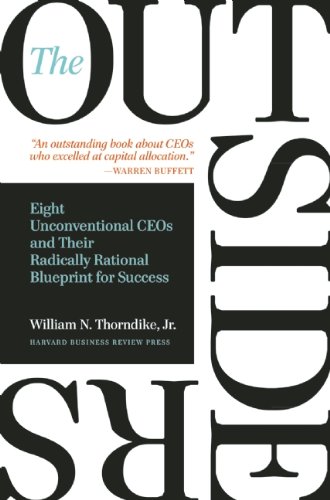

This article is an excerpt from the Shortform summary of "The Outsiders" by William N. Thorndike, Jr. Shortform has the world's best summaries of books you should be reading.
Like this article? Sign up for a free trial here .
What made Capital Cities Broadcasting successful? Was it the CEO, or good business practices, or both?
Capital Cities Broadcasting was a media company owning television stations, radio stations, and print publications. CEO Tom Murphy, in charge from 1966 to 1996, implemented management strategies that showed a 19.9% annual return rate, compared to the 10.1% for the S&P 500 and 13.2% return for leading media companies.
Tom Murphy, Capital Cities Broadcasting CEO, enacted several business policies during his tenure there that helped the company grow and succeed. Read about the history and major successes of Capital Cities Broadcasting.
Capital Cities Broadcasting: Successes
Capital Cities Broadcasting was a media company owning television stations, radio stations, and print publications. Outsider CEO Tom Murphy was CEO from 1966 to 1996.
In 1966, the market capitalization of Capital Cities Broadcasting was 6% that of CBS, the dominant media business in the country.
By 1996, when Capital Cities Broadcasting sold to Disney, it had rocketed past CBS and was now worth three times as much as CBS. It had acquired media giant ABC, which was dubbed by the press as akin to a “minnow swallowing a whale.” Relative to CBS, Capital Cities Broadcasting had grown nearly 50 times as much in the same period.
The strategy was simple and repeatable: buy media properties with attractive economics, improve operations to generate more cash, and use the cash to buy more media properties. Capital Cities Broadcasting had a management playbook that made it very effective at increasing revenue and cutting costs at its newly acquired companies. This created a “perpetual motion machine for returns.”
Capital Cities Broadcasting Performance
From 1966 to 1996, Capital Cities Broadcasting showed a 19.9% annual return rate, compared to the 10.1% for the S&P 500 and 13.2% return for leading media companies.
$1 invested at the beginning would have been worth $204 by 1996. This outperformed the S&P by 16.7 times, and his peers by almost 4 times.
Capital Cities Broadcasting History
Tom Murphy served in World War II and graduated from Harvard Business School in 1949. He worked as a product manager in consumer packaged goods for Lever Brothers until 1954, when his father’s friend Frank Smith told him about a TV station in Albany he’d purchased from bankruptcy. With no broadcasting experience, Murphy left to run the station day-to-day, with Smith running the business from downtown New York.
Murphy’s strategy was to improve programming to raise revenue and manage costs to reduce expenses. After a few years of losses, Murphy turned the station into a profitable cash generator. In 1957, they bought a second station in North Carolina, then a third one in Providence, and continuously from then on.
When Smith died in 1966, Murphy became CEO of Capital Cities Broadcasting. Murphy in turn promoted Dan Burke, a Harvard MBA he had hired 5 years earlier, to COO. They had a clean division of labor—Burke would focus on the day-to-day operations, while Murphy was responsible for capital allocations and acquisitions. In essence, Burke generated the free cash flow, and Murphy spent it.
At the time, Capital Cities Broadcasting had revenues of $28 million. Over the next few years, Murphy made large acquisitions.
- In 1967, Murphy bought a Houston ABC affiliate for $22 million, then the largest acquisition in broadcast history.
- In 1968, he bought Fairchild Communications, a trade magazine publisher, for $42 million.
- In 1970, he bought broadcaster Triangle Communications for $120 million.
At the time, the FCC allowed a company to own a maximum of five VHF TV stations, and Capital Cities Broadcasting had reached this maximum. Thus they turned to newspaper publishing, which had a similar business model as broadcasting. Once again, he had an appetite for acquisitions, buying newspapers for values in the high 8-figures in the 1970s. In 1980, he entered cable television by buying Cablecom for $139 million.
During the bear market of the early 1980s, Capital City shares were at single-digit P/E (price to earning) multiples. Murphy aggressively repurchased Capital City shares, eventually buying back close to half of standing shares.
In 1984, the FCC relaxed its maximum station limit, and in 1986 Capital Cities Broadcasting bought the ABC network for $3.5 billion, with financing help from Warren Buffett. As the largest transaction in business history outside of oil and gas, it stunned observers. ABC was bigger than Capital Cities Broadcasting at the time.
But Capital Cities Broadcasting treated ABC no differently than small local stations it had acquired. It cut costs aggressively, including ABC’s plush executive perks; it improved programming, in turn leading to better ratings and revenues. Soon ABC became more profitable than its competitors CBS and NBC.
In 1993, at 65, Burke retired from Capital Cities Broadcasting Now without a clear successor, Murphy met with Michael Eisner (CEO of Disney) in 1995, who was interested in buying Capital Cities Broadcasting. Murphy negotiated a $19 billion price, which was 28 times net income.
Under new leadership, Capital Cities found major success. Though the company was eventually sold, the profit signals a success for Murphy and Capital Cities.

———End of Preview———
Like what you just read? Read the rest of the world's best summary of William N. Thorndike, Jr's "The Outsiders" at Shortform .
Here's what you'll find in our full The Outsiders summary :
- What great CEOs like Warren Buffett do that average CEOs don't
- How to master the art of capital allocation
- How to be a great manager that your team is excited to work with






